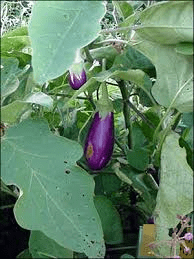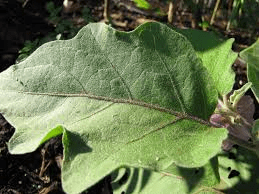Garden egg leaves, the foliage of the Solanum melongena plant, are vital components of its structure and function. These leaves play crucial roles in photosynthesis, transpiration, and overall plant health. Understanding the characteristics and functions of garden egg leaves is essential for successful cultivation and management of this vegetable crop.
The leaves of the garden egg plant are typically medium to dark green in color and vary in size and shape depending on the variety. They are simple leaves, meaning they have a single blade, and are arranged alternately along the stems. The leaf blade is generally ovate to lanceolate in shape, with a pointed tip and a slightly serrated margin. The surface of the leaf is often covered with small hairs, giving it a slightly fuzzy texture.
One of the primary functions of garden egg leaves is photosynthesis, the process by which plants convert light energy into chemical energy to produce carbohydrates. Chlorophyll, the green pigment in leaves, captures sunlight and uses it to drive the chemical reactions that synthesize sugars from carbon dioxide and water. These sugars serve as the plant’s primary source of energy for growth and development.
In addition to photosynthesis, garden egg leaves also play a role in transpiration, the process by which water vapor is released from the plant into the atmosphere. Transpiration occurs primarily through small pores called stomata, which are located on the underside of the leaves. Stomata open and close in response to environmental factors such as light intensity, temperature, and humidity, regulating water loss and gas exchange.
Garden egg leaves are also involved in nutrient uptake and storage. The leaf surface absorbs essential nutrients, such as nitrogen, phosphorus, and potassium, from the surrounding soil through tiny root hairs. These nutrients are transported via the plant’s vascular system to various tissues, where they are utilized for growth and metabolism. Excess nutrients may be stored in the leaves for future use or transported to other parts of the plant.
The health and vigor of garden egg leaves are influenced by various factors, including environmental conditions, nutrient availability, and pest and disease pressure. Optimal growth occurs in warm, sunny conditions with well-drained soil and adequate moisture. However, excessive heat or prolonged drought can stress the plant and lead to wilting or leaf damage.
Pests such as aphids, spider mites, and flea beetles, as well as diseases like powdery mildew and bacterial wilt, can also affect garden egg leaves. Pest infestations may result in leaf discoloration, distortion, or defoliation, while diseases can cause lesions, spots, or wilting. Implementing integrated pest management strategies, such as crop rotation, sanitation, and the use of resistant varieties, can help minimize these issues.
In summary, garden egg leaves are essential for the growth, development, and productivity of the Solanum melongena plant. They facilitate photosynthesis, transpiration, and nutrient uptake, supporting overall plant health and vigor. By understanding the characteristics and functions of garden egg leaves, growers can optimize cultivation practices and maximize crop yields.
The Economic Importance and Uses of Garden Egg Leaves

1. Nutritional Value: Garden egg leaves are rich in vitamins (A, B, and C), minerals (calcium, potassium, and iron), and dietary fiber. They contribute to a balanced diet and improve overall health.
2. Culinary Uses: In many cultures, garden egg leaves are used as a vegetable in soups, stews, and sauces. They add flavor, texture, and nutritional value to dishes.
3. Traditional Medicine: Garden egg leaves are used in traditional medicine for their purported health benefits, including the treatment of ailments like malaria, high blood pressure, and diabetes.
4. Livestock Feed: The leaves are used as feed for livestock, providing a nutritious supplement that enhances animal health and productivity.
5. Green Manure: When incorporated into the soil, garden egg leaves act as green manure, enriching the soil with organic matter and nutrients.
6. Compost Material: Garden egg leaves decompose to form compost, which improves soil structure and fertility.
7. Biofuel Production: The leaves can be used in the production of biofuels, offering a renewable energy source.
8. Biodegradable Products: Fibers from the leaves can be processed into biodegradable materials, reducing reliance on synthetic products.
9. Pest Control: Garden egg leaves can be used to make natural pesticides, helping to protect crops without harmful chemicals.
10. Soil Conditioner: Decomposed leaves improve soil texture and nutrient content, promoting healthy plant growth.
11. Mulch: Fresh or dried garden egg leaves can be used as mulch to conserve soil moisture and suppress weeds.
12. Anti-inflammatory Properties: Extracts from the leaves are studied for their anti-inflammatory properties, which can be used in medicinal products.
13. Antioxidant Source: The leaves contain antioxidants, which can help in preventing oxidative stress and chronic diseases.
14. Craft Materials: Dried leaves can be used in craft projects, providing a natural and sustainable material.
15. Educational Use: Garden egg leaves can be used in educational settings to teach about plant biology and ecology.
16. Research: The leaves are studied for their potential pharmaceutical applications, including treatments for various diseases.
17. Environmental Conservation: Utilizing garden egg leaves in various ways helps reduce agricultural waste and promotes sustainability.
18. Economic Livelihood: The cultivation and sale of garden egg leaves provide income for farmers and contribute to local economies.
Read Also: Bacterial Leaf Spot: Description, Damages Caused, Control and Preventive Measures
The Products and By-products That Can Be Derived From Garden Egg Leaves

1. Compost: Decomposed garden egg leaves are used to produce nutrient-rich compost for gardening and farming.
2. Animal Feed: The leaves are used as nutritious feed for livestock, enhancing their health and productivity.
3. Green Manure: Fresh leaves are plowed into the soil to improve its organic matter content and fertility.
4. Organic Mulch: Garden egg leaves are used as mulch to retain soil moisture, suppress weeds, and improve soil health.
5. Biofuel: The leaves are processed to produce biofuel, providing a renewable energy source.
6. Biodegradable Packaging: Processed fibers from the leaves are used to make eco-friendly packaging materials.
7. Natural Pesticides: Extracts from the leaves are formulated into natural pesticides to protect crops.
8. Skincare Products: Antioxidant-rich extracts from the leaves are used in creams, lotions, and other skincare products.
9. Food Supplements: The leaves are processed into dietary supplements to provide essential vitamins and minerals.
10. Anti-inflammatory Agents: Extracts from the leaves are used to develop anti-inflammatory medications.
11. Antioxidant Products: The leaves are used to produce antioxidant supplements that help in preventing oxidative stress.
12. Textile Fibers: The fibers from garden egg leaves can be processed into sustainable textiles for clothing and other fabric products.
13. Craft Materials: Dried leaves are used in craft projects and botanical art.
14. Educational Kits: The leaves are included in educational kits for teaching plant biology and ecology.
15. Plant-Based Stabilizers: Extracted compounds from the leaves are used as stabilizers in processed foods.
16. Natural Repellents: Leaf extracts are used to create natural repellents for pests and insects.
17. Industrial Enzymes: The leaves are used to produce enzymes for industrial applications, such as in detergents and bio-processing.
Read Also: Health Benefits and Side Effects of Opium Poppy (Papaver Somniferum)
Frequently Asked Questions (FAQ’s) About Garden Egg Leaves

1. What are garden egg leaves?
Garden egg leaves are the foliage of the garden egg plant (Solanum aethiopicum), commonly known as eggplant or aubergine.
2. Are garden egg leaves edible?
Yes, garden egg leaves are edible and are often used in soups, stews, and sauces.
3. What are the nutritional benefits of garden egg leaves?
Garden egg leaves are rich in vitamins A, B, and C, minerals like calcium, potassium, and iron, and dietary fiber.
4. How are garden egg leaves used in traditional medicine?
They are used to treat various ailments, including malaria, high blood pressure, and diabetes, due to their purported medicinal properties.
5. Can garden egg leaves be used as animal feed?
Yes, garden egg leaves can be used as nutritious feed for livestock.
6. How do garden egg leaves contribute to soil health?
When used as green manure or compost, garden egg leaves enrich the soil with organic matter and nutrients.
7. Are there industrial uses for garden egg leaves?
Yes, garden egg leaves can be processed into biofuel, biodegradable packaging, natural pesticides, and more.
8. Can garden egg leaves be used in skincare products?
Yes, antioxidant-rich extracts from garden egg leaves are used in skincare products like creams and lotions.
9. How do garden egg leaves help in pest control?
Extracts from the leaves can be formulated into natural pesticides to protect crops from pests.
10. What role do garden egg leaves play in environmental conservation?
Utilizing garden egg leaves in various applications helps reduce agricultural waste and promotes sustainability.
